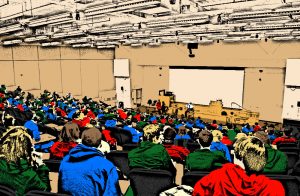
By Fahd Rafiq
As a PhD student in Political Science, I have spent most of my life in educational settings. From the time I graduated high school in 1998 until now, I’ve witnessed a transition from traditional chalk board teaching to PowerPoint slideshows. Although I believe PowerPoint slideshows can be useful, I argue that they are overused and can be a hindrance to student learning. Slides are often improperly designed containing irrelevant material, too much detail packed on a single slide, and distracting sounds and special effects. Slideshows also have the tendency of forcing the lecturer to focus on the covering the slides rather than interacting with students. As Driessnack (2005, p. 347) notes,
“When a PowerPoint slide is put on the screen, the students look at the slide, not at me. My voice, suspended in the air, is separated from me. The students do not see me, and I cannot see them.”
When an instructor is so focused on covering and clicking through the slides, students’ learning can become secondary and one can make the mistake of presuming that they have absorbed what’s on the slides.
Strategies for the classroom
I’ve found two alternatives to PowerPoint presentations—outlines and small groups–effective in in large classrooms. In the following sections, I’ll describe how they can be used to facilitate student learning.
Outlines
First, handing out lecture outlines can provide the structure often credited to PowerPoint slides. Lecture outlines  can help students and the instructor in not digressing, too often, from the topic. Lecture outlines should be thoughtfully prepared and should consider the level and goal of the course being taught. Outlines should not have too much detail, allowing students to fill in by listening to the lecture and paying attention to the discussion.
can help students and the instructor in not digressing, too often, from the topic. Lecture outlines should be thoughtfully prepared and should consider the level and goal of the course being taught. Outlines should not have too much detail, allowing students to fill in by listening to the lecture and paying attention to the discussion.
Research supports the option of using traditional teaching techniques by writing the basic outline and key concepts on the board prior to start of class (Lang, 2016). But for large introductory level courses, outline handouts serves the same purpose. Most studies show support for PowerPoint presentations by students for aesthetic reasons (Apperson et al., 2008) and because of the structure they afford (Susskind, 2004). Outlines complement PowerPoint lectures by allowing students to add their own notes to the slideshow.
Secondly, large classrooms can be broken into study groups. Study groups should be assigned group work that forces students to coordinate and cooperate with members. The instructor can also post questions in advance related to the reading(s) for the lecture and assign each group member one of the questions for that lecture. Students should have classroom time to discuss responses among group members. The professor can then raise questions and randomly select groups to answer. Afterwards, each group can consolidate their responses into a single group response sheet and email it to their assigned teaching assistant.
Critical thinking is among one of the most prized outcomes of a college education. Getting students to interact with each other keeps their minds active and allows them to consider other viewpoints that may not occur through individual work.
Small Tweaks to Slideshows
If you are using slideshows, consider complementing them with traditional chalk board lessons and video clips, when appropriate. Slideshows should not be long and expanded (Bartsch & Cobern, 2003) and lights should be dimmed to enhance the visuals (Apperson et al., 2008). The instructor should pause in-between slides and get students’ reactions to the material, as well as pose questions throughout to stimulate thinking.
Benedict Carey (2014) in How We Learn explains how the brain learns by using mixed techniques and in chunks, not by a constant feed of a single technique that puts the brain to sleep rather than keeping it active. PowerPoints can be excellent tool when used properly and in conjunction with methods that stimulate active learning. I hope the aforementioned techniques are useful in your teaching.
References
Apperson, J. M., Laws, E. L., & Scepansky, J. A. (2008). An assessment of student preferences for PowerPoint presentation structure in undergraduate courses. Computers & Education, 50(1), 148-153.
Bartsch, R. A., & Cobern, K. M. (2003). Effectiveness of PowerPoint presentations in lectures. Computers & Education, 41(1), 77-86.
Bok, D. (2009). Our underachieving colleges: A candid look at how much students learn and why they should be learning more. Princeton University Press.
Carey, B. (2014). How we learn. Macmillan.
Lang, J. (2016). Small teaching: Everyday lessons from the science of learning Jossey-Bass.
Savoy, A., Proctor, R. W., & Salvendy, G. (2009). Information retention from PowerPoint™ and traditional lectures. Computers & Education, 52(4), 858-867.
Susskind, J. E. (2005). PowerPoint’s power in the classroom: Enhancing students’ self-efficacy and attitudes. Computers & Education, 45(2), 203-215.
